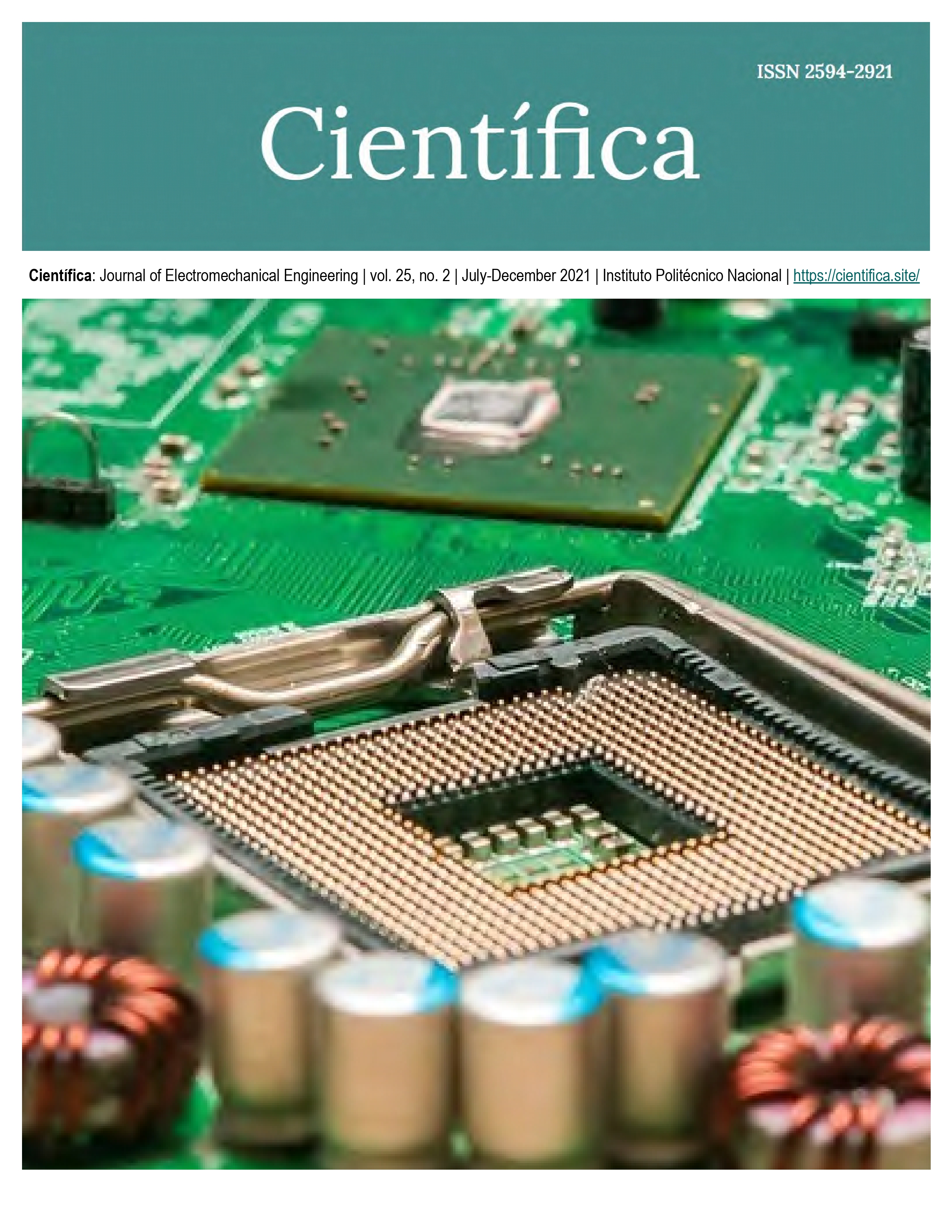Analysis of the sensitivity, small-signal and dynamic responses of a GMR sensor
DOI:
https://doi.org/10.46842/ipn.cien.v25n2a01Keywords:
small signal response, GMR sensors, magnetic sensors, dynamic sensitivity of GMR sensorsAbstract
In this paper the analysis of the sensitivity of a Giant Magnetoresistance-based sensor AAl002 type is carried out when it is used to measure time-varying magnetic fields superposed on static components. In order to obtain an experimental transfer characteristic from the output voltage of the GMR sensor, the magnetic field generated by a Helmholtz coil was measured. From the experimental transfer characteristic, it was obtained the sensitivity response of the GMR sensor and then it was experimentally validated. Results reveal that there exists a region in which the sensitivity response of the GMR sensor is linear. Outcomes show that to improve measurements of small time-varying magnetics fields, a polarization magnetic field should be used. The superadded magnetic field should be selected according to the type of in function time (ac or dc) magnetic field to be measured. The corresponding superadded magnetic field operation range for each measurement type are presented and described in this paper.
References
N. Novkovsky, “Progress and limitations in magnetic field measurements,” in Geomagnetics for Aeronautical Safety, First ed., J. Rasson and T. Delipetrov (Eds.). pp. 201-212, 2006.
M. Evans, Friedrich Heller, Environmental Magnetism: Principles and Applications of Enviromagnetics, San Diego, USA, 2003.
C. Zhu, L. Zhang, X. Shi, H. Qian, “Calibration strategy based on reference sensor for GMR biosensing and biodetection system,” 2016 13th IEEE Int. Conf. Solid-State Integr. Circuit Technol. ICSICT 2016 - Proc., pp. 1161–1163, 2017, doi: https://doi.org/10.1109/ICSICT.2016.7998681
P. Gao, X. Wang, D. Han, Q. Zhang, “Eddy Current Testing for Weld Defects with Different Directions of Excitation Field of Rectangular Coil,” 2018 4th Int. Conf. Control. Autom. Robot., pp. 486-491, 2018.
P. Gao, C. Wang, Y. Li, F. Li, Y. Yan, Y. Hu, “Defect evaluation using the phase information of an EC-GMR sensor,” Conf. Rec. - IEEE Instrum. Meas. Technol. Conf., pp. 25-29, 2014, doi: https://doi.org/10.1109/I2MTC.2014.6860516
W. H. Hayt, Teoría electromagnética, Mc Graw-Hill, USA, 2012, pp. 198-199.
J. García-Martín, J. Gómez-Gil, E. Vázquez-Sánchez, “Non-destructive techniques based on eddy current testing,” Sensors, vol. 11, no. 3, pp. 2525–2565, 2011, doi: https://doi.org/10.3390/s110302525
J. Garcia-Martin, J. Gomez-Gil, “Comparative evaluation of coil and hall probes in hole detection and thickness measurement on aluminum plates using eddy current testing,” Russ. J. Nondestruct. Test., vol. 49, no. 8, pp. 482-491, 2013, doi: https://doi.org/10.1134/S1061830913080044
C. Reig, S. Cardoso, S. C. Mukhopadhyay, Giant Magnetoresistance (GMR) Sensors, Berlin, Heidelberg: Springer Berlin Heidelberg, 2013.
T. Dogaru, S. T. Smith, “Giant Magnetoresistance-Based Eddy-Current Sensor,” IEEE Trans. Magn., vol. 37, no. 5, pp. 3831-3838, 2001.
N. G. Tawfik, Y. Hussein, E. Azab, “Analysis of magnetoresistive sensors for nondestructive evaluation,” 2018 IEEE Sensors Appl. Symp. SAS 2018 - Proc., vol. 2018, Jan., pp. 1-4, 2018, doi: https://doi.org/10.1109/SAS.2018.8336718
W. Wang, Y. Wang, L. Tu, T. Klein, Y. Feng, J.-P. Wang, “Surface Modification for Protein and DNA Immobilization onto GMR Biosensor,” IEEE Trans. Magn., vol. 49, no. 1, pp. 296–299, Jan. 2013, doi: https://doi.org/10.1109/TMAG.2012.2224327
R. Hamia, C. Cordier, C. Dolabdjian, “Eddy-current non-destructive testing system for the determination of crack orientation,” NDT E Int., vol. 61, pp. 24–28, 2014, doi: https://doi.org/10.1016/j.ndteint.2013.09.005
O. Postolache, A. L. Ribeiro, H. G. Ramos, “Uniform eddy current probe based on GMR sensor array and image processing for NDT,” 2012 IEEE I2MTC - Int. Instrum. Meas. Technol. Conf. Proc., pp. 458-463, 2012, doi: https://doi.org/10.1109/I2MTC.2012.6229366
A. Bernieri, G. Betta, L. Ferrigno, M. Laracca, “Improving performance of gmr sensors,” IEEE Sens. J., vol. 13, no. 11, pp. 4513–4521, 2013, doi: https://doi.org/10.1109/JSEN.2013.2271275
T. Sen, C. S. Anoop, S. Sen, “Simple linearising front-end-circuit for giant magneto-resistance sensors,” Electron. Lett., vol. 54, no. 2, pp. 81-83, 2018, doi: https://doi.org/10.1049/el.2017.3860
T. Sen, C. S. Anoop, S. Sen, “Design and performance evaluation of two novel linearisation circuits for giant magneto-resistance based sensors,” IET Circuits, Devices Syst., vol. 11, no. 5, pp. 496-503, 2017, doi: https://doi.org/10.1049/iet-cds.2017.0047
S. Dutta, T. Sen, C. S. Anoop, “Study and Noise Analysis of a Linearizing Front-End Circuit for GMR Sensors,” IEEE Reg. 10 Annu. Int. Conf. Proceedings/TENCON, vol. 2019, Oct., pp. 2275-2279, 2019, doi: https://doi.org/10.1109/TENCON.2019.8929701
P. Ripka, M. Tondra, J. Stokes, R. Beech, “AC-driven AMR and GMR magnetoresistors,” Sensors Actuators, A Phys., vol. 76, no. 1-3, pp. 225-230, 1999, doi: https://doi.org/10.1016/S0924-4247(99)00034-5
Z. Li, S. Dixon, “A Closed-Loop Operation to Improve GMR Sensor Accuracy,” IEEE Sens. J., vol. 16, no. 15, pp. 6003–6007, 2016, doi: https://doi.org/10.1109/JSEN.2016.2580742
J. Han, J. Hu, Y. Ouyang, S. X. Wang, J. He, “Hysteretic modeling of output characteristics of giant magnetoresistive current sensors,” IEEE Trans. Ind. Electron., vol. 62, no. 1, pp. 516-524, 2015, doi: https://doi.org/10.1109/TIE.2014.2326989
I. Jedlicska, R. Weiss, R. Weigel, “Linearizing the output characteristic of GMR current sensors through hysteresis modeling,” IEEE Trans. Ind. Electron., vol. 57, no. 5, pp. 1728-1734, 2010, doi: https://doi.org/10.1109/TIE.2009.2033090
F. Xie, R. Weiss, R. Weigel, “Hysteresis Compensation Based on Controlled Current Pulses for Magnetoresistive Sensors,” IEEE Trans. Ind. Electron., vol. 62, no. 12, pp. 7804-7809, 2015, doi: https://doi.org/10.1109/TIE.2015.2458958
N. O. Romero-Arismendi, J. A. Pérez-Benitez, E. Ramírez-Pacheco, J. H. Espina-Hernández, “Sensors and Actuators A : Physical Design method for a GMR-based eddy current sensor with optimal sensitivity,” Sensors Actuator A Phys., vol. 314, 2020, doi: https://doi.org/10.1016/j.sna.2020.112348
E. Ramírez-Pacheco, J. H. Espina-Hernández, F. Caleyo, J. M. Hallen, “Defect detection in aluminium with an eddy currents sensor,” Proc. - 2010 IEEE Electron. Robot. Automot. Mech. Conf. CERMA 2010, pp. 765-770, 2010, doi: https://doi.org/10.1109/CERMA.2010.91
N. O. R. Arismendi, E. R. Pacheco, J. H. Espina-Hernandez, J. A. P. Benítez, “Estudio de la influencia de las características físicas de la bobina y el descentrado bobina-sensor GMR en el sistema de detección de defectos por corrientes de remolino,” Congr. Nac. Ing. Electr. y Sistemas, no. XVI, 2017.
Downloads
Published
Issue
Section
License
Copyright (c) 2024 Instituto Politecnico Nacional

This work is licensed under a Creative Commons Attribution-NonCommercial-ShareAlike 4.0 International License.

